Dynamic Typography: Bringing Text to Life via Video Diffusion Prior

Text animation serves as an expressive medium, transforming static communication into dynamic experiences by infusing words with motion to evoke emotions, emphasize meanings, and construct compelling narratives. Crafting animations that are semantically aware poses significant challenges, demanding expertise in graphic design and animation. We present an automated text animation scheme, termed "Dynamic Typography", which combines two challenging tasks. It deforms letters to convey semantic meaning and infuses them with vibrant movements based on user prompts. Our technique harnesses vector graphics representations and an end-to-end optimization-based framework. This framework employs neural displacement fields to convert letters into base shapes and applies per-frame motion, encouraging coherence with the intended textual concept. Shape preservation techniques and perceptual loss regularization are employed to maintain legibility and structural integrity throughout the animation process. We demonstrate the generalizability of our approach across various text-to-video models and highlight the superiority of our end-to-end methodology over baseline methods, which might comprise separate tasks. Through quantitative and qualitative evaluations, we demonstrate the effectiveness of our framework in generating coherent text animations that faithfully interpret user prompts while maintaining readability. Our code is available at: https://animate-your-word.github.io/demo/.
Reka Core, Flash, and Edge: A Series of Powerful Multimodal Language Models
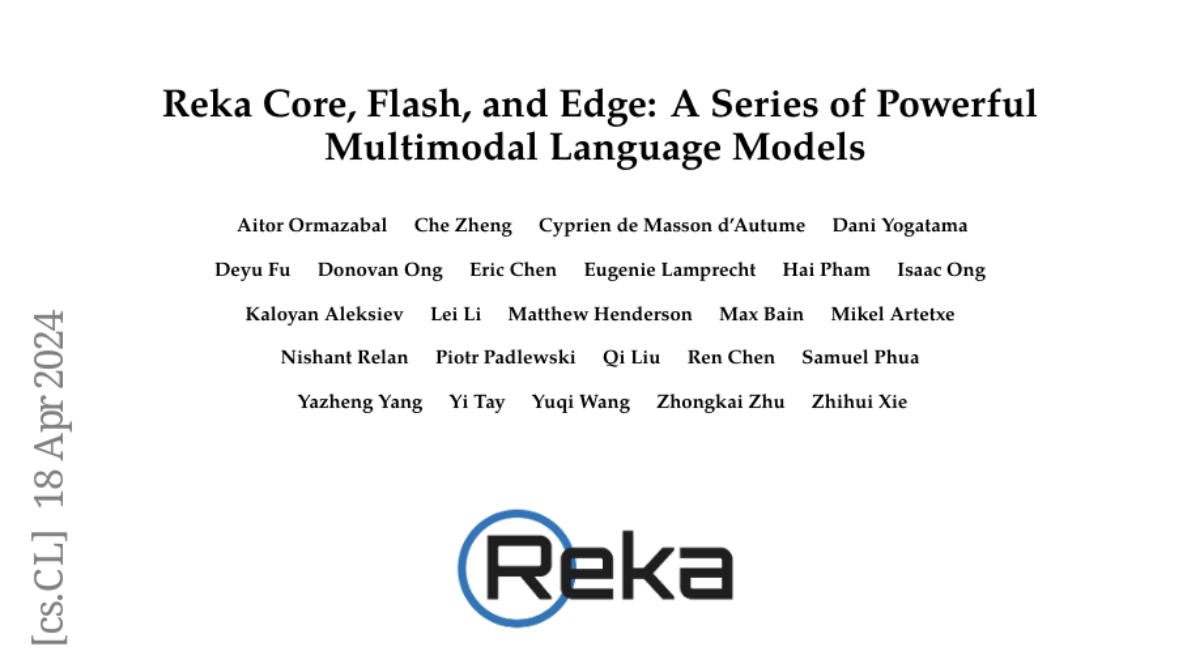
We introduce Reka Core, Flash, and Edge, a series of powerful multimodal language models trained from scratch by Reka. Reka models are able to process and reason with text, images, video, and audio inputs. This technical report discusses details of training some of these models and provides comprehensive evaluation results. We show that Reka Edge and Reka Flash are not only state-of-the-art but also outperform many much larger models, delivering outsized values for their respective compute class. Meanwhile, our most capable and largest model, Reka Core, approaches the best frontier models on both automatic evaluations and blind human evaluations. On image question answering benchmarks (e.g. MMMU, VQAv2), Core performs competitively to GPT4-V. Meanwhile, on multimodal chat, Core ranks as the second most preferred model under a blind third-party human evaluation setup, outperforming other models such as Claude 3 Opus. On text benchmarks, Core not only performs competitively to other frontier models on a set of well-established benchmarks (e.g. MMLU, GSM8K) but also outperforms GPT4-0613 on human evaluation. On video question answering (Perception-Test), Core outperforms Gemini Ultra. Models are shipped in production at http://chat.reka.ai . A showcase of non cherry picked qualitative examples can also be found at http://showcase.reka.ai .
BLINK: Multimodal Large Language Models Can See but Not Perceive

We introduce Blink, a new benchmark for multimodal language models (LLMs) that focuses on core visual perception abilities not found in other evaluations. Most of the Blink tasks can be solved by humans "within a blink" (e.g., relative depth estimation, visual correspondence, forensics detection, and multi-view reasoning). However, we find these perception-demanding tasks cast significant challenges for current multimodal LLMs because they resist mediation through natural language. Blink reformats 14 classic computer vision tasks into 3,807 multiple-choice questions, paired with single or multiple images and visual prompting. While humans get 95.70% accuracy on average, Blink is surprisingly challenging for existing multimodal LLMs: even the best-performing GPT-4V and Gemini achieve accuracies of 51.26% and 45.72%, only 13.17% and 7.63% higher than random guessing, indicating that such perception abilities have not "emerged" yet in recent multimodal LLMs. Our analysis also highlights that specialist CV models could solve these problems much better, suggesting potential pathways for future improvements. We believe Blink will stimulate the community to help multimodal LLMs catch up with human-level visual perception.
TriForce: Lossless Acceleration of Long Sequence Generation with Hierarchical Speculative Decoding
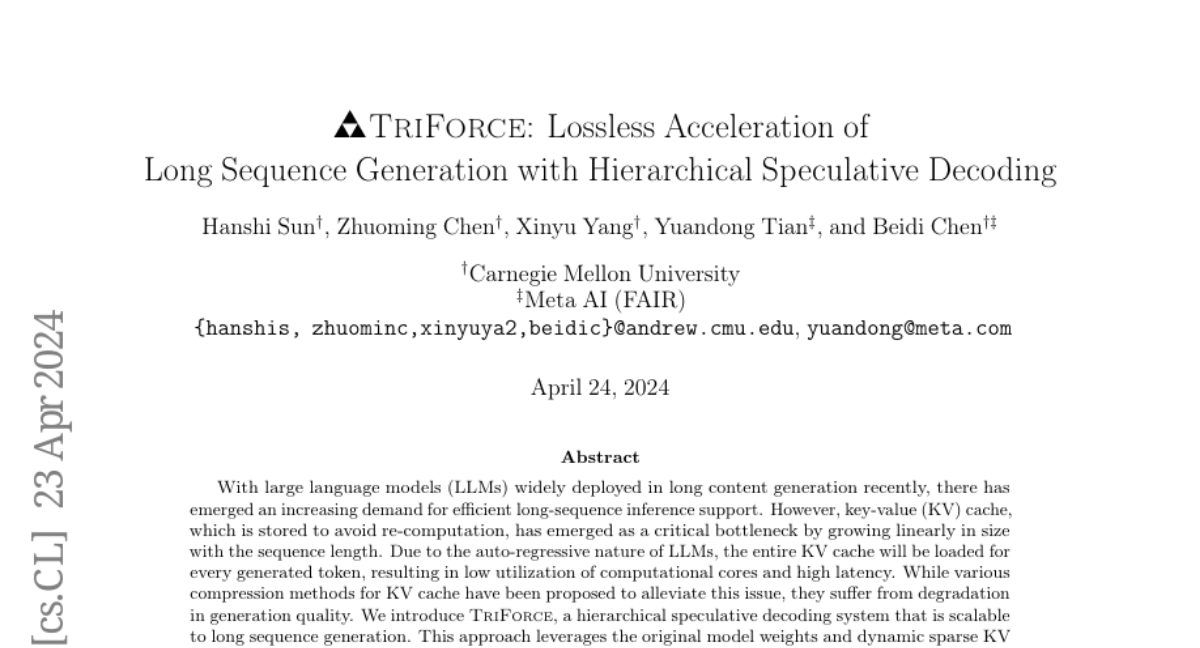
With large language models (LLMs) widely deployed in long content generation recently, there has emerged an increasing demand for efficient long-sequence inference support. However, key-value (KV) cache, which is stored to avoid re-computation, has emerged as a critical bottleneck by growing linearly in size with the sequence length. Due to the auto-regressive nature of LLMs, the entire KV cache will be loaded for every generated token, resulting in low utilization of computational cores and high latency. While various compression methods for KV cache have been proposed to alleviate this issue, they suffer from degradation in generation quality. We introduce TriForce, a hierarchical speculative decoding system that is scalable to long sequence generation. This approach leverages the original model weights and dynamic sparse KV cache via retrieval as a draft model, which serves as an intermediate layer in the hierarchy and is further speculated by a smaller model to reduce its drafting latency. TriForce not only facilitates impressive speedups for Llama2-7B-128K, achieving up to 2.31$\times$ on an A100 GPU but also showcases scalability in handling even longer contexts. For the offloading setting on two RTX 4090 GPUs, TriForce achieves 0.108s/token$\unicode{x2014}$only half as slow as the auto-regressive baseline on an A100, which attains 7.78$\times$ on our optimized offloading system. Additionally, TriForce performs 4.86$\times$ than DeepSpeed-Zero-Inference on a single RTX 4090 GPU. TriForce's robustness is highlighted by its consistently outstanding performance across various temperatures. The code is available at https://github.com/Infini-AI-Lab/TriForce.
Toward Self-Improvement of LLMs via Imagination, Searching, and Criticizing
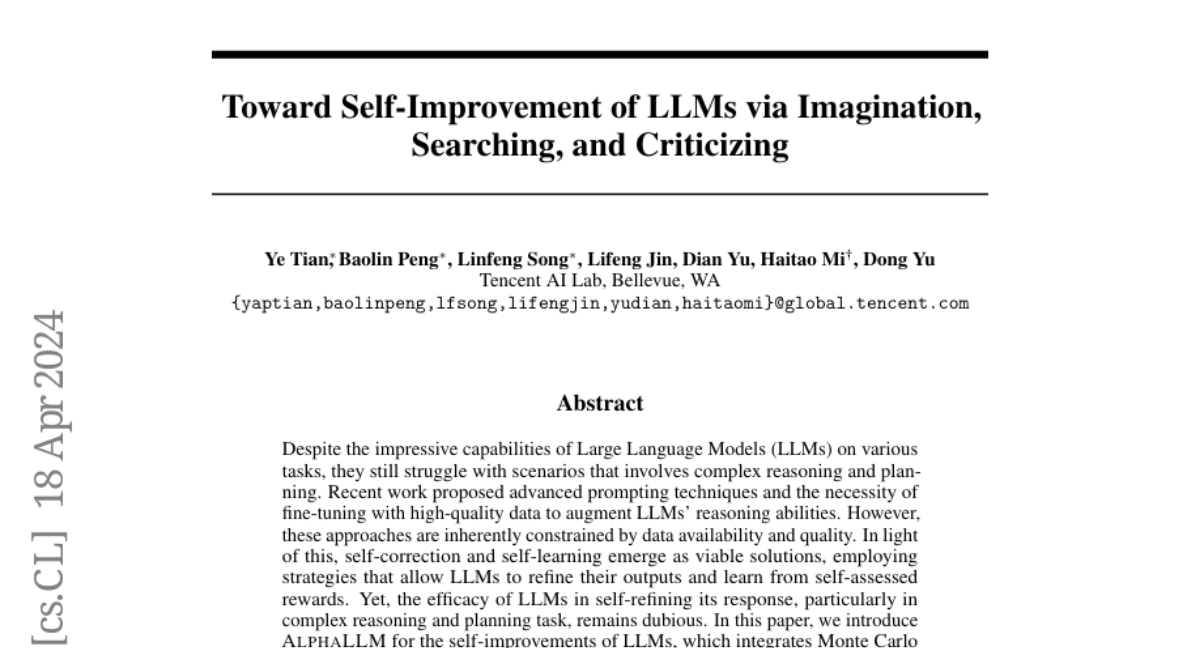
Despite the impressive capabilities of Large Language Models (LLMs) on various tasks, they still struggle with scenarios that involves complex reasoning and planning. Recent work proposed advanced prompting techniques and the necessity of fine-tuning with high-quality data to augment LLMs' reasoning abilities. However, these approaches are inherently constrained by data availability and quality. In light of this, self-correction and self-learning emerge as viable solutions, employing strategies that allow LLMs to refine their outputs and learn from self-assessed rewards. Yet, the efficacy of LLMs in self-refining its response, particularly in complex reasoning and planning task, remains dubious. In this paper, we introduce AlphaLLM for the self-improvements of LLMs, which integrates Monte Carlo Tree Search (MCTS) with LLMs to establish a self-improving loop, thereby enhancing the capabilities of LLMs without additional annotations. Drawing inspiration from the success of AlphaGo, AlphaLLM addresses the unique challenges of combining MCTS with LLM for self-improvement, including data scarcity, the vastness search spaces of language tasks, and the subjective nature of feedback in language tasks. AlphaLLM is comprised of prompt synthesis component, an efficient MCTS approach tailored for language tasks, and a trio of critic models for precise feedback. Our experimental results in mathematical reasoning tasks demonstrate that AlphaLLM significantly enhances the performance of LLMs without additional annotations, showing the potential for self-improvement in LLMs.
AniClipart: Clipart Animation with Text-to-Video Priors

Clipart, a pre-made graphic art form, offers a convenient and efficient way of illustrating visual content. Traditional workflows to convert static clipart images into motion sequences are laborious and time-consuming, involving numerous intricate steps like rigging, key animation and in-betweening. Recent advancements in text-to-video generation hold great potential in resolving this problem. Nevertheless, direct application of text-to-video generation models often struggles to retain the visual identity of clipart images or generate cartoon-style motions, resulting in unsatisfactory animation outcomes. In this paper, we introduce AniClipart, a system that transforms static clipart images into high-quality motion sequences guided by text-to-video priors. To generate cartoon-style and smooth motion, we first define B\'{e}zier curves over keypoints of the clipart image as a form of motion regularization. We then align the motion trajectories of the keypoints with the provided text prompt by optimizing the Video Score Distillation Sampling (VSDS) loss, which encodes adequate knowledge of natural motion within a pretrained text-to-video diffusion model. With a differentiable As-Rigid-As-Possible shape deformation algorithm, our method can be end-to-end optimized while maintaining deformation rigidity. Experimental results show that the proposed AniClipart consistently outperforms existing image-to-video generation models, in terms of text-video alignment, visual identity preservation, and motion consistency. Furthermore, we showcase the versatility of AniClipart by adapting it to generate a broader array of animation formats, such as layered animation, which allows topological changes.
Reuse Your Rewards: Reward Model Transfer for Zero-Shot Cross-Lingual Alignment

Aligning language models (LMs) based on human-annotated preference data is a crucial step in obtaining practical and performant LM-based systems. However, multilingual human preference data are difficult to obtain at scale, making it challenging to extend this framework to diverse languages. In this work, we evaluate a simple approach for zero-shot cross-lingual alignment, where a reward model is trained on preference data in one source language and directly applied to other target languages. On summarization and open-ended dialog generation, we show that this method is consistently successful under comprehensive evaluation settings, including human evaluation: cross-lingually aligned models are preferred by humans over unaligned models on up to >70% of evaluation instances. We moreover find that a different-language reward model sometimes yields better aligned models than a same-language reward model. We also identify best practices when there is no language-specific data for even supervised finetuning, another component in alignment.
MoA: Mixture-of-Attention for Subject-Context Disentanglement in Personalized Image Generation
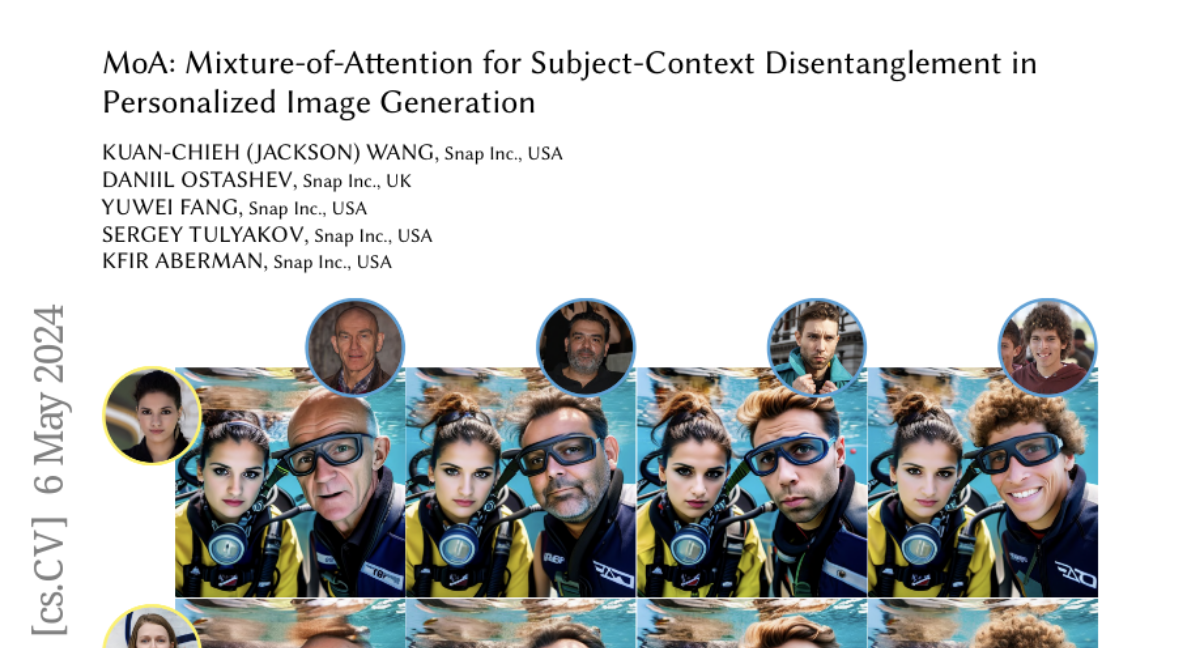
We introduce a new architecture for personalization of text-to-image diffusion models, coined Mixture-of-Attention (MoA). Inspired by the Mixture-of-Experts mechanism utilized in large language models (LLMs), MoA distributes the generation workload between two attention pathways: a personalized branch and a non-personalized prior branch. MoA is designed to retain the original model's prior by fixing its attention layers in the prior branch, while minimally intervening in the generation process with the personalized branch that learns to embed subjects in the layout and context generated by the prior branch. A novel routing mechanism manages the distribution of pixels in each layer across these branches to optimize the blend of personalized and generic content creation. Once trained, MoA facilitates the creation of high-quality, personalized images featuring multiple subjects with compositions and interactions as diverse as those generated by the original model. Crucially, MoA enhances the distinction between the model's pre-existing capability and the newly augmented personalized intervention, thereby offering a more disentangled subject-context control that was previously unattainable. Project page: https://snap-research.github.io/mixture-of-attention
Introducing v0.5 of the AI Safety Benchmark from MLCommons
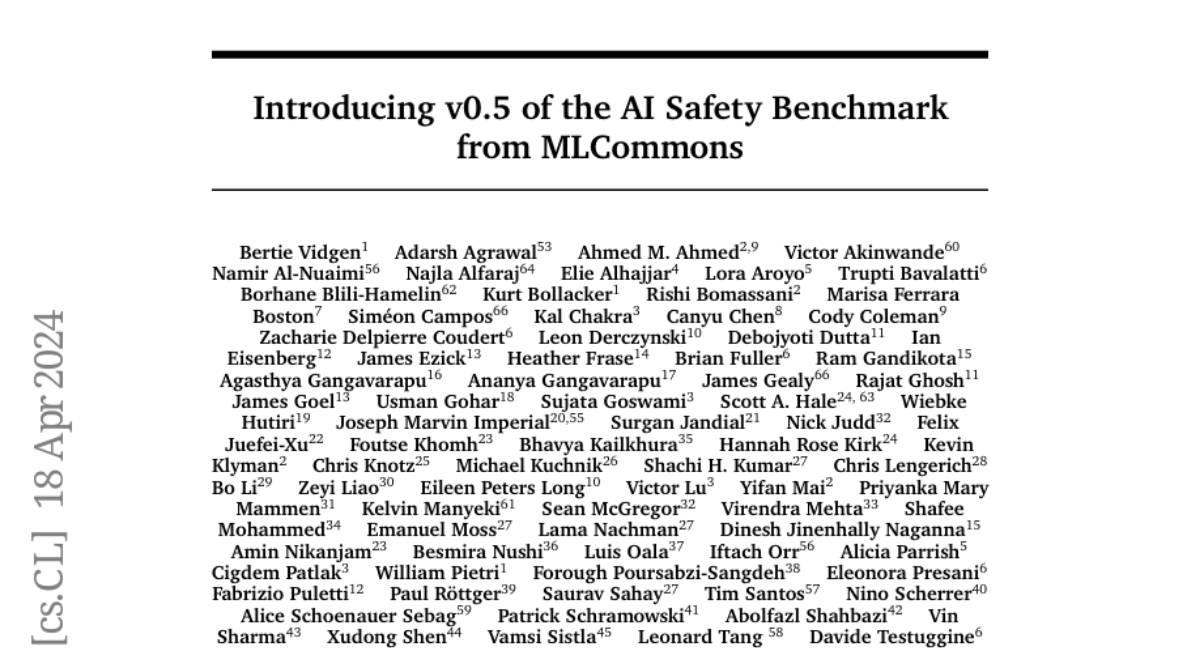
This paper introduces v0.5 of the AI Safety Benchmark, which has been created by the MLCommons AI Safety Working Group. The AI Safety Benchmark has been designed to assess the safety risks of AI systems that use chat-tuned language models. We introduce a principled approach to specifying and constructing the benchmark, which for v0.5 covers only a single use case (an adult chatting to a general-purpose assistant in English), and a limited set of personas (i.e., typical users, malicious users, and vulnerable users). We created a new taxonomy of 13 hazard categories, of which 7 have tests in the v0.5 benchmark. We plan to release version 1.0 of the AI Safety Benchmark by the end of 2024. The v1.0 benchmark will provide meaningful insights into the safety of AI systems. However, the v0.5 benchmark should not be used to assess the safety of AI systems. We have sought to fully document the limitations, flaws, and challenges of v0.5. This release of v0.5 of the AI Safety Benchmark includes (1) a principled approach to specifying and constructing the benchmark, which comprises use cases, types of systems under test (SUTs), language and context, personas, tests, and test items; (2) a taxonomy of 13 hazard categories with definitions and subcategories; (3) tests for seven of the hazard categories, each comprising a unique set of test items, i.e., prompts. There are 43,090 test items in total, which we created with templates; (4) a grading system for AI systems against the benchmark; (5) an openly available platform, and downloadable tool, called ModelBench that can be used to evaluate the safety of AI systems on the benchmark; (6) an example evaluation report which benchmarks the performance of over a dozen openly available chat-tuned language models; (7) a test specification for the benchmark.
OpenBezoar: Small, Cost-Effective and Open Models Trained on Mixes of Instruction Data

Instruction fine-tuning pretrained LLMs for diverse downstream tasks has demonstrated remarkable success and has captured the interest of both academics and practitioners. To ensure such fine-tuned LLMs align with human preferences, techniques such as RLHF and DPO have emerged. At the same time, there is increasing interest in smaller parameter counts for models. In this work, using OpenLLaMA 3Bv2 as a base model, we describe the recipe used to fine-tune the OpenBezoar family of models. In this recipe: We first generate synthetic instruction fine-tuning data using an open and commercially non-restrictive instruction fine-tuned variant of the Falcon-40B model under three schemes based on: LaMini-LM, WizardLM/Evol-Instruct (with databricks-dolly-15k as a seed dataset) and Orca (with the Flan Collection as a seed dataset), then filter these generations using GPT-4 as a human proxy. We then perform cost-effective QLoRA-based supervised fine-tuning sequentially with each scheme. The resulting checkpoint is further fine-tuned with a subset of the HH-RLHF dataset to minimize distribution shift prior to using the DPO loss to obtain the final checkpoint. Evaluation is done with the LM Eval Harness tasks/metrics as well as on MT-Bench using the "LLM-as-a-judge" framework with Claude 2.1, with the finding that the final checkpoint, "OpenBezoar-HH-RLHF-DPO", demonstrates superior performance over many models at the 3B parameter scale, even outperforming the top model in one of the categories on the Huggingface Open LLM Leaderboard. We release "OpenBezoar-SFT", "OpenBezoar-HH-RLHF-SFT", "OpenBezoar-HH-RLHF-DPO" checkpoints, alongside our generated datasets on HuggingFace at https://huggingface.co/collections/SurgeGlobal/open-bezoar-6620a24923e12127e9e2b9cc and our codebase at https://bitbucket.org/paladinanalytics/workspace/projects/OP.
MeshLRM: Large Reconstruction Model for High-Quality Mesh

We propose MeshLRM, a novel LRM-based approach that can reconstruct a high-quality mesh from merely four input images in less than one second. Different from previous large reconstruction models (LRMs) that focus on NeRF-based reconstruction, MeshLRM incorporates differentiable mesh extraction and rendering within the LRM framework. This allows for end-to-end mesh reconstruction by fine-tuning a pre-trained NeRF LRM with mesh rendering. Moreover, we improve the LRM architecture by simplifying several complex designs in previous LRMs. MeshLRM's NeRF initialization is sequentially trained with low- and high-resolution images; this new LRM training strategy enables significantly faster convergence and thereby leads to better quality with less compute. Our approach achieves state-of-the-art mesh reconstruction from sparse-view inputs and also allows for many downstream applications, including text-to-3D and single-image-to-3D generation. Project page: https://sarahweiii.github.io/meshlrm/
EdgeFusion: On-Device Text-to-Image Generation

The intensive computational burden of Stable Diffusion (SD) for text-to-image generation poses a significant hurdle for its practical application. To tackle this challenge, recent research focuses on methods to reduce sampling steps, such as Latent Consistency Model (LCM), and on employing architectural optimizations, including pruning and knowledge distillation. Diverging from existing approaches, we uniquely start with a compact SD variant, BK-SDM. We observe that directly applying LCM to BK-SDM with commonly used crawled datasets yields unsatisfactory results. It leads us to develop two strategies: (1) leveraging high-quality image-text pairs from leading generative models and (2) designing an advanced distillation process tailored for LCM. Through our thorough exploration of quantization, profiling, and on-device deployment, we achieve rapid generation of photo-realistic, text-aligned images in just two steps, with latency under one second on resource-limited edge devices.